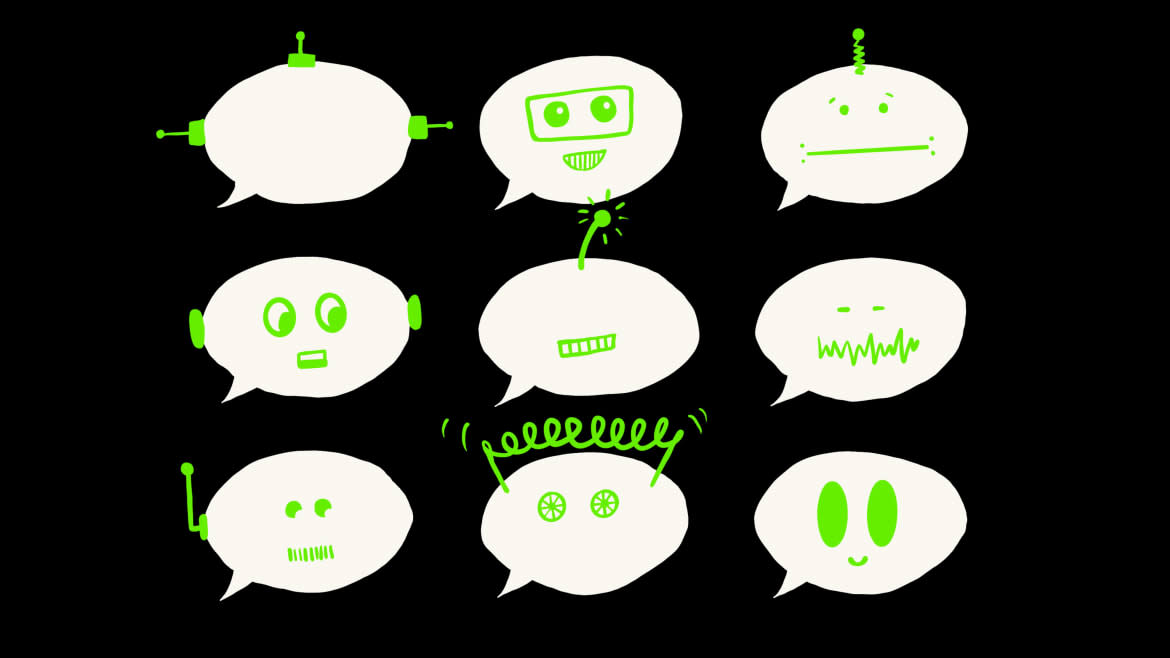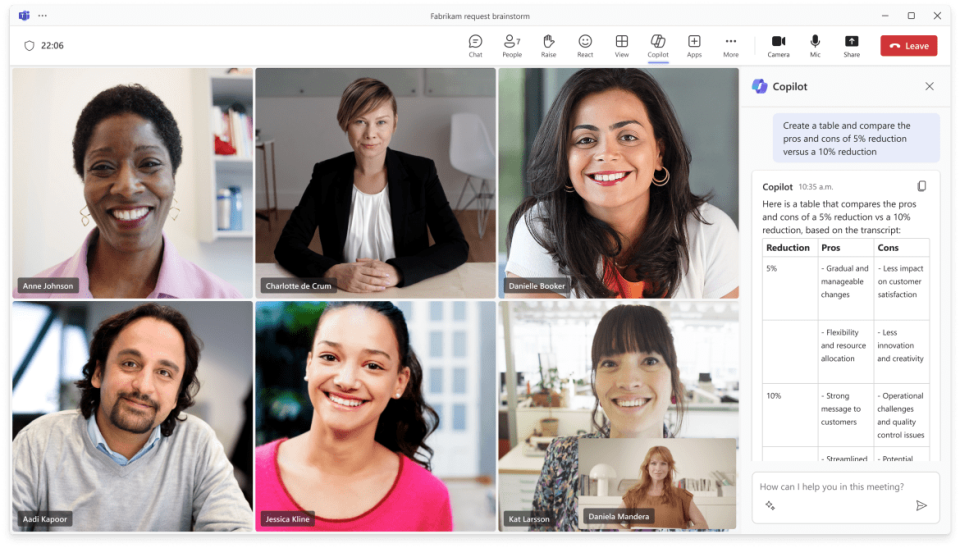Are AI Chatbots About to Make Work Meetings Worse Than Ever?

Ever since video calls infiltrated our work lives in 2020, employers have lassoed us into more and more online meetings (many of which probably could’ve been emails). In fact, over the last three years, people have attended 192 percent more Microsoft Teams meetings and calls per week compared to pre-pandemic times, the company reported in May.
Now, tech giants like Microsoft and Google say they have a solution to the very meeting malaise that they helped create: They’re enlisting chatbots, the buzzy artificial intelligence tools that mimic conversations among humans, to make digital gatherings more meaningful and efficient.
You’ve likely heard of Open AI’s chatbot, ChatGPT, which is now used for everything from cheating in class and writing music to churning out scientific papers. Now, Microsoft has used the same model behind ChatGPT to create its own trusty work assistant called Copilot. On Nov. 1, businesses that have signed up for Microsoft 365’s enterprise plans can use the assistant for tasks such as transcribing and summarizing meetings, assembling lists of action items, and even highlighting each time a specific colleague is mentioned during a call.
Among its most useful features, Copilot can attend meetings when you can’t—if you happen to miss a call, the chatbot can catch you up in a matter of minutes, Derek Snyder, senior director of Microsoft Teams, told The Daily Beast. Snyder explained that enterprise customers can quickly access the relevant files, skim through automatically annotated sections of the recording, and ask questions about the meeting’s content (“What were the strongest opinions?”).
“One of the biggest [Copilot] use cases is for people to have the joy of missing out,” Snyder said. “To be able to miss a meeting and not actually have to worry about that.”
Microsoft isn’t the only company sending bots to our meetings. This past August, Google announced a similar feature from its Duet AI assistant, which can attend calls “on your behalf.” Unlike Microsoft’s Copilot, Duet AI was built on internally developed models. Thousands of companies are already using the new tool, a Google spokesperson told The Daily Beast.
In September, Zoom unveiled its own AI assistant that comes with the paid version of the software, which can also sum up meetings you weren’t able to attend (or maybe just didn’t feel like tuning into).
So, that begs the question: What happens if we all decide to skip our calls and send in the bots instead? Google claims a meeting won’t work if everyone recruits their AI assistant, The Verge reported. But it isn’t guaranteed that people won’t think of clever hacks to skirt calls—creating digital “clones” of ourselves isn’t out of the question, Amany Elbanna, a professor in information systems and digital transformation at Royal Holloway University of London, told The Daily Beast.
Ultimately, these new AI-powered features could forever transform online meetings as we know them—and potentially call into question their purpose in the first place.
Work Smarter, Not Harder
While it’s tempting to assume the worst, chatbots may not necessarily deprive digital workplaces of human connections. If done right, they could make our work lives better, Christopher Flathmann, a professor of human-centered computing at Clemson University, told The Daily Beast.
“I don’t think the majority of people have meetings to get things done and be productive,” Flathmann said.
For instance, we should aim to settle into a “flow state” when collaborating with colleagues so we can stay laser-focused on the task at hand and think creatively. But stopping to take notes or set reminders can throw us off track. With the help of chatbots, we may not have to worry about missing small details as our brain juices flow.
They also offer a discreet way to ask questions we may feel embarrassed by, Amany Elbanna of Royal Holloway University of London said. While we may fear some eye rolls when asking our boss to repeat a certain point, these AI bots can offer clarity without broadcasting the fact that you’re tripped up.
Artists Can Now Sabotage AI Image Generators to Fight Art Theft
Still, it’s easy to imagine meetings turning into bot-dominated spaces and eventually disappearing altogether—but that doesn’t seem to be the intention from companies like Microsoft (at least on the surface). People may attend an hour-long meeting for only two minutes of meaningful insight, Colette Stallbaumer, general manager of Microsoft 365, told The Daily Beast.
“Meetings are not going away,” Stallbaumer said. “They’re a super important part of how we all work, but they’re not the only way we work.”
At the moment, chatbots can only do so much and often even produce biased and incredibly misleading results. In fact, the large language models (LLMs) behind tools like Copilot and ChatGPT frequently just make things up, a phenomenon also known as hallucination. Research has shown that users can be susceptible to what a chatbot is telling them even when they’re aware they’re talking to an AI.
Derek Snyder of Microsoft said that his team tweaked the model they adapted from OpenAI to limit this, but he noted that it’s still possible that Copilot could spit out some untruths. He also added certain restrictions to Copilot to avoid office conflict, like preventing people from asking about the “mood” of a certain meeting or whether someone was particularly unhelpful during a call.

A screenshot of Microsoft's new AI infused work meetings. On November 1, businesses that have signed up for Microsoft 365’s enterprise plans can use the assistant for tasks such as transcribing and summarizing meetings, assembling lists of action items, and even highlighting each time a specific colleague is mentioned during a call.
It’s unclear how well these office chatbots will play out in the real world. Given the tech industry’s nearly mythological ambitions for AI, it’s easy enough to overestimate a chatbot’s abilities. However, at the moment, these tools can’t pick up on the specific details needed to adapt to an individual workplace, Flathmann said. They also have trouble translating its general knowledge scraped from across the internet into action.
When he uses ChatGPT to write emails, for example, Flathmann often has to edit the text to incorporate language that’s specific to his team and their work. “[Chatbots] are really good at knowing things and they’re less good at doing things,” he said.
While today’s workplace AI tools have relatively basic features to enhance meetings, we could expect some significant developments in coming years and even months due to the breakneck speed of AI development. These bots could help make calls more engaging by turning your brainstorms into vivid images, Flathmann said. Microsoft’s Bing Chat AI already creates custom images via text prompts, and Snyder thinks this type of feature could eventually come to Copilot.
Digital Water Cooler Gossip
Flathmann also suggested that these models could detect and help resolve conflicts between coworkers. Researchers have recently looked into using AI for this purpose, and it could be possible to incorporate several models into call software to pick up on disagreements and suggest ways to solve them. Chatbots themselves can’t deduce how we’re feeling, but they could digest information picked up by other models on certain cues and work from there.
However, it’s possible that a private AI company contracted to do this work digests coworker drama and shares it with bosses or even third parties. It would be critical for employees to know exactly where this information ends up, Flathmann said.
Some companies already offer AI-powered software that can analyze behavior like our speech, along with eye and facial movements, to guess our mood during sales calls and gauge our reaction to a certain product (a process known as sentiment analysis in the industry.) Last year, Zoom said they were experimenting with this concept, and Snyder of Microsoft said his team may look into sentiment analysis more broadly.
AI Deepfakes Are Making War in Ukraine Even More Chaotic and Confusing
Such data would be highly sensitive, but the tech titans claim they’re already keeping our information secure. Copilot and other Microsoft AI models don’t train on customer data, Stallbaumer of Microsoft said. Instead, it lives in a private database with permissions set by the customer.
Google told The Daily Beast that the prompts and content generated by the chatbot stay within the organization’s Workspace app and noted that “none of your content is used for model training outside of your domain without permission.” Zoom similarly states that the company won’t harness this information to train its models or those obtained from third parties.
Still, it isn’t guaranteed that every company will safeguard your data, Flathmann said. A large number of organizations still haven’t created specific policies to address this issue.
Attack of the Digital Clones
Despite the general consensus on avoiding bot-filled echo chambers during meetings, Flathmann and Elbanna said people may get creative to avoid calls. While it’s not feasible at the moment, some tech-savvy slackers could create digital “clones” of themselves and program them to respond during conversations. Since 2020, several companies and even a bored engineer have proposed that very idea.
Since some people are already harnessing AI to work multiple jobs, Elbanna predicts that this trick could help them appear simultaneously “present” in various workplaces. “Are we having a generation where people are just playing too much with their life, intensifying it far too much to the extent that they will get burnout very quickly in their career?”
Flathmann and Elbanna think it’s best to train people to work well with AI in order to improve—and not replace—our unique skills that automatons could never acquire, such as our ability to form connections among colleagues. This could include learning ways to write more specific, constructive prompts for chatbots to help us accomplish more mundane tasks like drafting emails or memos. Ultimately, though, the shift could force organizations to contend with the purpose of their meetings, and ideally move beyond the pandemic-induced digital drudgery.
In other words, it might take an AI revolution in order for companies to finally understand what meetings could have been an email.
“We don’t want to have a world in which AI replaces humans,” Flathmann said. Instead, organizations should “help humans learn to use them as productive tools or teammates where they can occupy a unique space where… humans still do the things they’re best at, which is being creative and facilitating human-to-human interaction.”
Get the Daily Beast's biggest scoops and scandals delivered right to your inbox. Sign up now.
Stay informed and gain unlimited access to the Daily Beast's unmatched reporting. Subscribe now.

